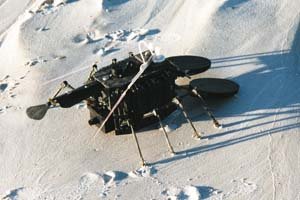Robolobster - Military tools for land and sea operations
Have you all guys ever seen a robot that looks like a lobster? In fact, unknown to many people, the most amazing capability of a lobster is that they have a very sharp sense of smell, which they used to detect and trace the odor of their food to its source in the turbulent conditions of the ocean. Recently, scientists have been working in a new field which is known as biomemetic robots. They believe that we, as human beings can solve real world problems by dissecting this and other forms of animal intelligence and use this kind of knowledge to design and program autonomous machines with similar superhuman capabilities. Such kind of robots can explore the ocean bed and track underwater sources of pollution, detect and locate mines and other unexploded ordances, e.t.c.

Thus, this blog gives an opportunity to do an introduction and know more about the operation of biomimetic underwater robots, Robolobster at Northeastern University, Marine science centre at Nahant, Mass. These robots are being designed and built in a way that they resemble and behave like a real lobster. In fact, it is important to take note that these robots are able to take advantage of capabilities proven in animals,i.e lobsters for dealing with real-world environments. This is a US Navy research project and the military organization are making use of the versatility of the robot’s operation on both water and land for conduction of mine detection, rescue and search operations in different kinds of enviroments.
Fig 1: A picture of Robolobster
Feature and technology of the Robolobster
The robot has a body size of an 8” by 5” hull , width of about two feet long, has eight legs and weight about seven pounds on land.
It is found out that these underwater robots are more negatively buoyant compared to real underwater animals, therefore the robots will have a higher chance of experience a surge in the underwater and try to move around at the bottom due to its light weight. The eight legs of the robot thus provide an advantage of more traction to gain a higher mobility in these kinds of situations.
The robot has dedicated artificial muscles which are responsible for its leg movement, which is made of a nickel-titanium alloy called nitinol. This material will contract when electricity is applied and expands, thus it has a certain degree of resemblance to real muscles involved. Thus, the mobility of the underwater robots is being made easier in this kind of architecture.
The main power source of the robot comes from a rechargeable NiMH or lithium ion polymer battery pack and it will be controlled by a neuronal-circuit based controller. The function of this controller is to carry out a set of behavioral actions which mimics the motion of lobsters adapting to the environment in which they carry out their target search movement. One example is that lobsters will wiggle and squirm in order to get out of a stuck spot. Thus, the controller will incorporate a variable level of chaos in its own circuitry so that the robots will generate locomotion such that the locomotoring pattern will have own variations, which constitute the wiggling and squirming that enables the robots to get out of stuck spots.
The RoboLobster will have sensors that would detect metal, chemicals and explosive objects of other underwater vehicles during their land and underwater operation. A video camera has been used before in the prototype testing and has been proved to be successful but the limitation of this capability is that its effectiveness depends on the availability of the light.
Deployment of Robolobster
The deployment of Robolobster is carried out in a few certain ways. The first approach is to release four to five robots in a designated area. Each of these robots will be programmed to explore the area in a random manner, whenever it detects an unknown object, it would transmit the information in form of RF wave signals to military personnel on the surface. The robot will be rigged with a small explosive charge and the personnel can signal it to detonate the mine.
Fig 2: Robolobster movement in underwater
During the deployment, each of these robots will be placed with a sonar marker to delineate a particular area for them to explore. The purpose is to let each robot communicate with each other so that one can signal to another that they has crossed an invisible boundary and should stay away from it. Upon completing their search mission, they are signaled to gather at a certain location where they can be retrieved or proceed to the mode of self destruction. In conclusion, the RoboLobster are considered autonomous machine in the sense that their legs are equppied with preprogrammed sensors that will prohibit them from moving when it encounters an object. However, they are not fully considered autonomous because the command to self-detonate, for example, would most likely come from military personnel.
Hope you all enjoy this interesting blog!!!
Fig 3: Robolobster movement on land

